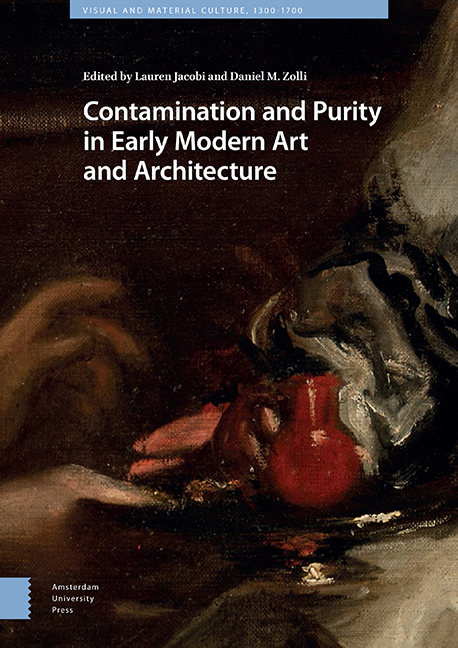Book contents
- Frontmatter
- Contents
- List of Illustrations
- Introduction: Contamination and Purity in Early Modern Art and Architecture
- 1 Generation and Ruination in the Display of Michelangelo’s Non-finito
- 2 The Sacrilege of Soot: Liturgical Decorum and the Black Madonna of Loreto
- 3 Sedimentary Aesthetics
- 4 ‘Adding to the Good Silver with Other Trickery’ : Purity and Contamination in Clement VII’s Emergency Currency
- 5 Tapestry as Tainted Medium: Charles V’s Conquest of Tunis
- 6 Bruegel’s Dirty Little Atoms
- 7 Leakage, Contagion, and Containment in Early Modern Venice
- 8 Contamination, Purification, Determinism: The Italian Pontine Marshes
- 9 Colonial Consecrations, Violent Reclamations, and Contested Spaces in the Spanish Americas
- 10 Contamination | Purification
- Index
2 - The Sacrilege of Soot: Liturgical Decorum and the Black Madonna of Loreto
Published online by Cambridge University Press: 27 May 2021
- Frontmatter
- Contents
- List of Illustrations
- Introduction: Contamination and Purity in Early Modern Art and Architecture
- 1 Generation and Ruination in the Display of Michelangelo’s Non-finito
- 2 The Sacrilege of Soot: Liturgical Decorum and the Black Madonna of Loreto
- 3 Sedimentary Aesthetics
- 4 ‘Adding to the Good Silver with Other Trickery’ : Purity and Contamination in Clement VII’s Emergency Currency
- 5 Tapestry as Tainted Medium: Charles V’s Conquest of Tunis
- 6 Bruegel’s Dirty Little Atoms
- 7 Leakage, Contagion, and Containment in Early Modern Venice
- 8 Contamination, Purification, Determinism: The Italian Pontine Marshes
- 9 Colonial Consecrations, Violent Reclamations, and Contested Spaces in the Spanish Americas
- 10 Contamination | Purification
- Index
Summary
Abstract
The sanctuary of Loreto, one of Italy's most renowned pilgrimage destinations, was built to house the relic of the Virgin Mary's childhood home, but many pilgrims directed their prayers instead to the shrine's cult image, a Marian statue with a dark appearance. In the late sixteenth century, a time of Catholic reform, many devotees attributed the sculpture's color to the residue from candle smoke, despite the fact that this departed from reformers’ strict rules of liturgical decorum. The perception of the Virgin of Loreto's blackened surface as simultaneously sacred and sacrilegious returned agency to the artwork itself. The statue's sooty accretions suggested negligence and cried out for restoration, but they also defended the cult of images in early modern Catholicism.
Keywords: blackness, miraculous images, Catholic reform, decorum, restoration, Virgin Mary
Early modern authors lavished praise upon the cult statue of the Madonna of Loreto (Fig. 2.1). The work, a wooden statuette of the Virgin and Child measuring just over three feet tall, stood above the main altar of the Holy House of Loreto in the Marche region along Italy's Adriatic coast. The sanctuary claims to possess the actual childhood home of the Virgin Mary, transported by angels from Palestine in 1294 (Fig. 2.2). Devotion to this remarkable room relic increased greatly in the late fifteenth century, but in subsequent centuries, the modest sculpture above the altar became increasingly central to the religious experience at Loreto. In addition to defending the shrine's miraculous foundation, early modern histories of the site extol the virtues of the cult statue, often attributed to St. Luke, pronouncing it ‘a most beautiful simulacrum’ and ‘as great as a mortal could possibly do.’ Our own assessments of the Madonna of Loreto might today be less effusive. Its unremarkable appearance is similar to many other wooden Gothic sculptures of the same subject, and its surface, moreover, is dark and damaged.
Amidst their praises, early modern descriptions of the Madonna of Loreto do register this darkened appearance, albeit briefly. Late sixteenth and seventeenthcentury texts began to account for the dark color of their most beautiful Madonna, variously describing the work as ‘shaded with brown’ or ‘blackened’ – the latter word connoting either hue or material corruption.
- Type
- Chapter
- Information
- Publisher: Amsterdam University PressPrint publication year: 2021

